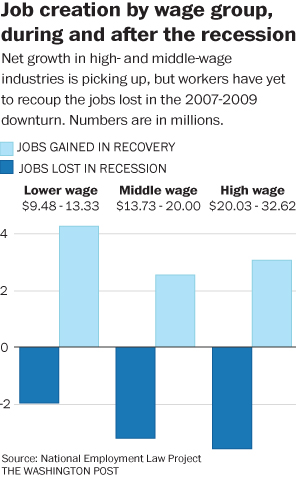Better-paying jobs stage a comeback
Construction is one of the higher-wage industries showing recent growth in hiring. (Mark Lennihan/AP)
By Ylan Q. Mui
August 17 at 7:52 PM - The Washington Post
The recovery in Americafs job market is finally spreading to industries with
good pay after years of being concentrated in fields with low wages.
Hiring has picked up steam in areas such as construction, manufacturing and
professional services in recent months — sectors with a median hourly wage of at
least $20. Nearly 40 percent of the jobs created over the past six months have
been in high-wage industries, compared with just a quarter during the last half
of 2013, according to an analysis by the National Employment Law Project for The
Washington Post. Meanwhile, growth in many low-paying jobs has leveled off or
even declined.
gI often hear that the recovery is only in low-wage jobs. That is
categorically inaccurate,h Labor Secretary Thomas E. Perez said in an interview.
gThis recovery is creating a lot of good jobs.h
If those trends hold, economists say it could mean that the bumpy road back
from recession is beginning to even out — particularly if it means that more
jobs with better pay can help boost household income.

When averaged across all occupations, the median hourly wage has fallen 3.4
percent since the recession, after adjusting for inflation, according to NELP research to be released
Monday. Many economists, including Federal Reserve Chair Janet L. Yellen, have
pointed to an increase in earnings as one of the key missing pieces of the
recovery.
Yellen and dozens of other top economists from around the world will convene
in Wyoming this week to discuss the health of the U.S. labor market.
gWhat I think matters most is wages,h NELP Executive Director Christine L.
Owens said. gIn terms of just looking at the balance, the crisis is as much a
crisis of wages as it is which jobs are being created.h
Matthew Gallagher, 26, has been waiting four years for his break. After
graduating college magna cum laude, the Dallas resident struggled to find
full-time work. He settled for part-time jobs at a local museum and as an animal
massage therapist — even though his degree is in public relations.
But his prospects may be brightening. After a year-long search, Gallagher
landed a position developing online educational courses two weeks ago. Itfs
another part-time job, but this one holds full-time potential.
gI feel itfs a little ridiculous,h Gallagher said. gI was told constantly
that you need to go to college to get a good job, and I have just this year
broken into double-digit hourly wages.h
Even before the recession began, the economy was experiencing what academics
call job polarization: growth at the high and low ends of the pay scale,
but not much movement in the middle.
Two major factors drove this shift: new technologies that replaced some
skilled workers and increased competition from the international labor
market.
The countryfs deep downturn skewed that dynamic even further.
Businesses of all stripes slashed jobs during the recession, but low-wage
industries such as retail and food service bounced back most quickly. They now
employ 2.3 million more workers than they did in 2007, according to NELP.
Middle- and high-wage sectors have yet to recoup the ground they lost. NELP
estimates that about 1.2 million jobs are still missing. But the pickup in
hiring in recent months suggests the economy may be entering an inflection
point.
gWhat was so unusual about this recovery was that the low-wage industry
growth was faster than high-wage growth for so long after the recovery began,h
said Sam Coffin, an economist at UBS.
Coffin said low-wage sectors tend to grow faster during the first two years
after a recession before other industries catch up. But itfs been five years
since the recession ended, and his research shows that higher-paying jobs began
to outpace others only in the past three months.
In his analysis, Coffin divided employment into two categories: jobs that pay
above and below the national median wage.
A more detailed breakdown by JPMorgan senior economist Robert Mellman
separated growth by high-wage professional and managerial occupations from those
in the low-paying service sector. It showed the turning point in job creation
started at the end of last year.
But perhaps most surprising, Mellman said, was the simultaneous rise in all
other occupations, which he classified as middle-wage jobs. That was
largely driven by a surge in manufacturing, transportation and construction —
the same sectors long buffeted by technology and globalization.
gFor the jobs in the middle, maybe the ones that are going have all gone, and
now youfre growing from a lower base,h Mellman said.
At Simmons Machine Tools, President David Davis said the company plans to
hire 10 people over the next six months. About 100 people work at the plant in
Albany, N.Y., which manufactures equipment to help maintain trains and subway
cars. Davis said the company was able to avoid layoffs during the recession but
has also been cautious about expanding during the recovery.
gOnce we hire, thatfs generally because therefs some systemic foundational
growth thatfs going on in the business,h he said.
Though the majority of the companyfs sales are international — Simmons also
employs 1,000 workers at a plant in Germany and an additional 150 in China —
Davis said he is starting to see pressures on wages in the United States. The
open jobs require specialized technical skills that can be hard to find.
gThose people donft grow on trees,h Davis said. gYou kind of have this
premium. The employees that you do have youfre trying to keep.h
Ylan Q. Mui is a financial reporter at The
Washington Post covering the Federal Reserve and the economy.